My memories of Logan – More Than Feudin’ and Fightin’
By Elizabeth Thurmond Witschey
This article was originally published in the Spring 2000 edition of the Goldenseal Magazine. It is published here with their permission and our special thanks.
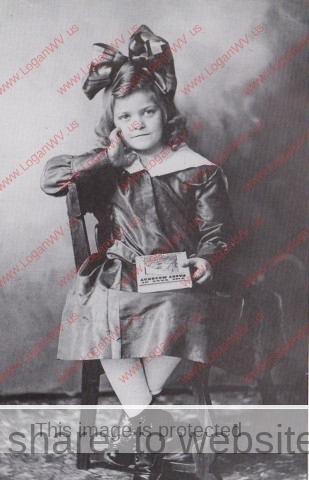
Back when I was a child, there was more going on in Logan than feudin’ and fightin’ and mine wars. Those were the events that made the newspapers, but the outside world had no idea of how wonderful it was to live in Logan, how much fun we had, or how many exciting cultural and entertainment events rode the rails into our little town.
In 1914, Logan began bursting its seams, which up until then had consisted of a sizable hill on one side and a lazy little fish-filled stream on the other. As the area coal business began to prosper and expand, satellite industries kept up the rigorous pace and the population of Logan exploded.
As always with a population explosion, the need for school facilities increased. It wasn’t long until a new junior/senior high school was built beside the ancient grade school. Mr. F.O. Woerner –know to us as “Perfesser” – reigned with an iron ruler and no one even thought of misbehaving when he was nearby. He not only kept us in line, he scared us to death – every minute of the school day. Even so, he was loved and respected as long as he lived.
Summertime in Logan meant long lazy days swimming and swinging from wild grapevines over the Guyandotte River (locally known as the Guyan River). On the last swing out, we’d let go with that deliciously scary feeling of falling out of control, until we were jolted back to our senses with the smack of the water against sunburned bodies. This activity resulted in sore muscles and skin that smarted hours afterward.
A few years later, we deserted that swimming hole for another in the nearby town of McConnell. It was just as much fun, but dangerously deep! And although we felt more daring, we were never quite as comfortable as we had been back at our old swimming hole in Logan.
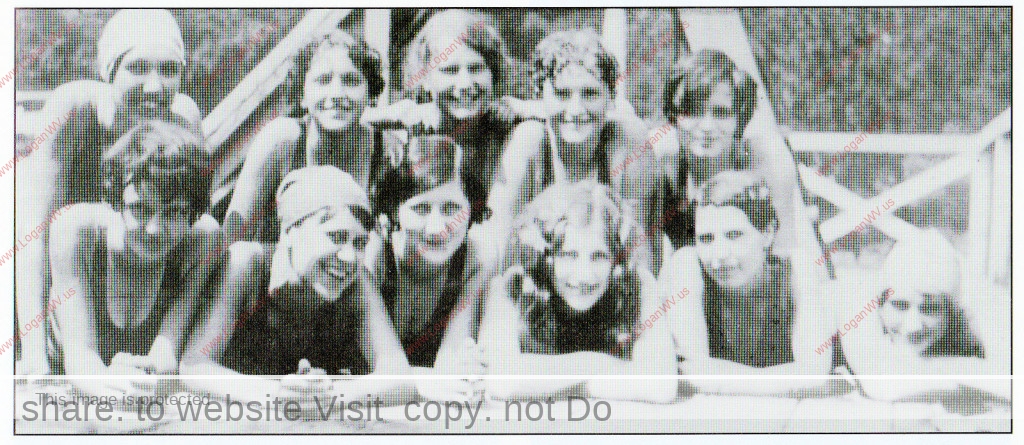
I remember long hay rides. In those days, we frequently persuaded Mr. J.J. Hinchman to fill the back of his huge truck with straw. About 20 kids piled in and we’d be off to some mountain spot to roast hot dogs, toast marshmallows, gobble potato salad, and gulp lemonade by moonlight. There was a lot of singin’ and not a little courtin’ going on during these evenings. Try to imagine a mad and frustrated chaperone, or a young girl visibly embarrassed because her mother had come along. All the way home we harmonized on “Down By the Old Mill Stream,” “School Days,” “I’m Forever Blowin’ Bubbles” and “Row, Row, Row Your Boat.”
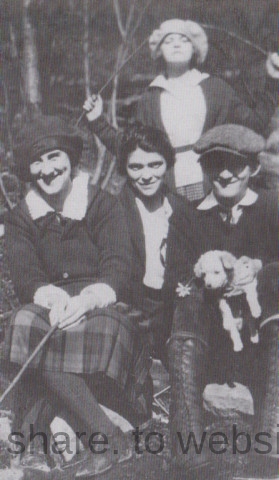
Ward Rock was an unforgettable landmark high on the hill above the high school. It was flat as a griddle and large enough for 15 or 20 kids. I never knew who originated the “let’s hike to Ward Rock” idea, but several times each year word spread that “that Saturday morning” we would make the trek. Alarms were set for 4:30 a.m., and we went to sleep dreaming of the fun-filled day that lay ahead. About 5:00 a.m. in the morning, starting with those who lived in the east end of town, one by one they came down Stratton Street, winding around Dead Man’s Curve, stopping at every gate whistling and yelling “Get up or we’re gonna leave ya!”
By the time we reached the foot of the hill, there was quite a group. Somehow, Ione Hall, the school music teacher, was always the one who got the job of chaperoning. Maybe it was because she was the youngest on the staff. It was dark as pitch that time of the day and cold enough to freeze a bird’s wing, so we all wore heavy coats caps and boots. We could hardly make the climb for all our heaving clothing but when we finally reached the summit, it felt like we were on top of the world! The sunrise seen half a century later by astronauts circling the globe was never more glorious than that brilliant diamond ball rising slowly from the hills.
Two events in May were anticipated all through the year. The first was the field day event, now call track and field. There was no county unit system in the schools then The counties were divided into districts. Each school in the district had tryouts for the various races; the winners participated in the big race on field day.
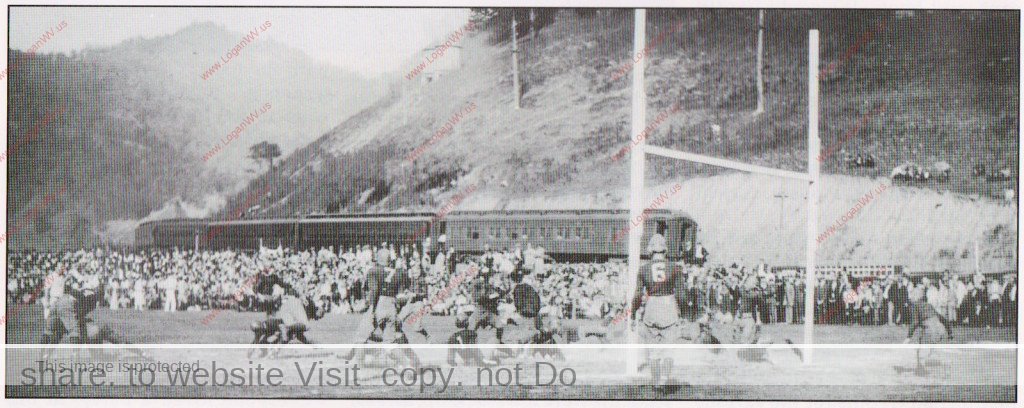
(This is the field where Monitor Drive-In was located.)
Field day was always wonderful – usually hot and sunny. We crowded into cars and trucks or caught the local train for the short trip to Monaville, a coal town a few miles from Logan. Monaville – named for Mona Wilkinson, daughter of Judge Wilkinson who owned the land – had the only athletic field in Logan County large enough to accommodate the meet.
Field day was a long day and when it was over, everyone had seen enough 100-yard dashes, pole vaulting, and shot puts to last until the year. Between athletic events, there was plenty of time to eat lunch, drink warm soda pop, make new friends, fight with rivals from other schools, and sometimes start a new romance with handsome athlete from a neighboring school.
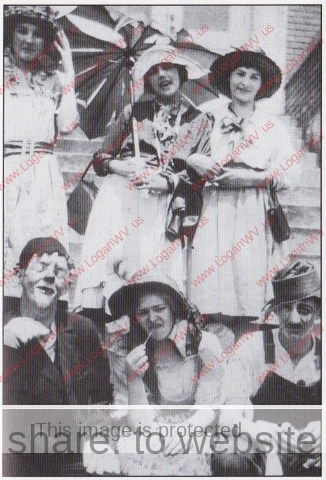
The other big event in May was “Tacky Day.” For weeks everyone accumulated crazy, worn-out, raggedy clothes for the occasion. Some students were too stuck-up, afraid, or shy to “dress tacky.” But those who did participate were the strangest sight ever imagined. We had a ball, but how the teachers stood us in class all day long, I ‘ll never know. During lunch hour and after school, we roamed the streets of Logan giggling and preening in our ridiculous outfits. People stopped and stared in disgust, amusement, and disbelief. No matter the reactions, it bothered us not one iota.
One of the great delights in those days was walking home after school. School buses were nonexistent, and no one who lived with three or four miles of the school would have been caught dead riding instead of strolling home with the gang. On cold winter afternoons, those who had a nickel went to the little hole-in-the-wall hot dog stand just beyond the railroad tracks. No hot dogs were better. The steamed buns were soft and warm and the wieners were juicy and spicy, especially when smothered with chopped onions and chili. When the weather got warmer we stopped at the grocery store on Stratton Street and bought giant-sized dill pickles and gnawed on them all the way home.
Everyone loved a party! In our early party days, an evening’s entertainment was spin the plate, musical chairs, and post office. The refreshments were usually ice cream and cookies or cake, hot cocoa in the winter, and lemonade in the summer. Many were the pre-party cuts and stings I received from squeezing lemons all afternoon. Party hours were 7:00 to 9:00 p.m., and I was severely lectured when I didn’t arrive home promptly afterward.
For dances, there were no local orchestras. For small gatherings, we met in one another’s homes, rolled up the rungs, sprinkled corn meal on the floors, and Haskell Johnson played the piano for us till she dropped. Everybody knew how to dance. Helen Cox Schrader came from Charleston once a week and conducted dance classes. Those who didn’t attend were taught by those who did. Soon all the kids were gliding across the floor to the strains of “All Alone” or jumping to the “Finale Hop.” For something different, we did an inept and rather awkward version of the tango to “Hindustan” or waltzed to “Let Me Call You Sweetheart.”
Big dances took place at the Aracoma Hotel, the armory, the Holden clubhouse, or a big hall at Lundale. Orchestras came by train from Huntington or Cincinnati. Once Fats Waller came – now that was Big Time! He had a mile-wide grin, and his fat stubby fingers flew across the piano keys while he stomped the beat with his black shiny shoes.
Intellectual improvements were not overlooked in Logan and the ladies of the town were the primary promoters. One of the most outstanding and brilliant women was Mrs. Innis Davis. Nothing was ever the same after she became involved. She organized the Woman Club in the early 1920’s and had the half the ladies in town enrolled in the Delphian Society – a sort of intellectual mail-order club. She then decided that Logan needed a library. She persuaded influential citizens to donate a second-floor room in the old courthouse. Since I was out of school for the summer, she summoned me – Mrs. Davis never asked and never took “no” for an answer – to keep a catalog of the books we received and to help with acquisitions. That entire summer I never had time to swim. Instead, I became Logan’s first librarian.
Innis Davis’ greatest love was the Baptist church. Someone once asked her what she’d do if she ever moved to a town where there wasn’t a Baptist church. Her instant replay was, “I’d start one!” She later moved to Charleston with her husband Tom where she eventually was appointed head of the State Museum and Archives.
No one contributed more to cultural life in Logan than Jeannette C. Sayer. She came to Logan from her native Cincinnati after World War I and taught piano and was the organist and choir director at the Nighbert Memorial Methodist Church for more than 40 years. Every spring she presented all of her piano students at a formal evening recital conducted in the sanctuary. It began with the youngest and newest students and ended with the most advanced. For years, Sarah Land (Holland) was last on the program. She was not only the best of Miss Sayre’s students, but also the prettiest. To the rest of us it seemed a very long evening, indeed!
Through her choirs, Miss Sayre introduced Logan to cantatas, oratorios, Christmas carols other that “Silent Night,” and the best of classical and religious music. Although she never appeared anywhere as a soloist, she played the great music of Bach, Handel, Mozart, and all the masters at church services. She was truly a living symbol of music in Logan.
Another fine musician was Myrtle Stone, the movie pianist. On Saturday afternoons, all the kids went to the old Bennett Theatre to see silent picture shows starring William S. Hart in a Western or the latest installment of Billie Burke in “Gloria’s Romance.” Myrtle played the piano bringing forth wild sounds, eerie noises, or quiet gentle tones to punctuate the action on the screen. She was a one-woman orchestra. She made us shiver with fright during the “Perils of Pauline.” She made us drown in romance with Mary Pickford. Her gift of improvisation was amazing. She never missed a beat as the action on the screen constantly changed. She never looked at her hands and she never so much as blinked an eye.
Two exciting annual events were on everyone’s calendar: Lyceum in winter and Chautauqua in summer. Both played to packed audiences. The Lyceum programs took place at the high school auditorium. There people listened spellbound to Russell H. Conwell deliver his famous lecture, “Acres of Diamonds.” Ida M. Tarbell, muckraker newswoman and friend of Georgia O’Keeffe, gave an evening of fiery commentary on everything happening in the world. One vivid memory is of a sensational group of our African boys in their native beads and dress – or undress – singing and beating their strange-looking drums in a unique rhythm unlike anything ever before heard in Logan.
Chautauqua was more fun! It was conducted in a giant tent pitched in a vacant field near the home of Aunt Vicey Nighbert. Each afternoon and evening there was classy entertainment by musical groups, soloists, choral groups, and instrumentalists. Well-known actors appeared in traveling Broadway productions. All of this was more or less for the adults with performances in the afternoon and evening. Best of all were the morning sessions when “children’s Chautauqua” convened. Kids of all ages attended in droves. There were stories, games, reading contests, and the thrilling rehearsals for the children’s production which took place on the final night. Heady stuff for kids living in Logan in the ‘20’s.
You see, Logan wasn’t just feduin’ and fightin’ and mine wars. It was paradise.
Elizabeth Witschey Today
by Sheila McEntee
Recounting tales of her girl-hood in Logan, an engaging and articulate Elizabeth Thurmond Witschey gestures with animation. Her eyes sparkle and a ready smile lights her face. While she conveys some of her fondest personal memories, there is a broader message she does not want her listener to miss.
“Logan was a great place to grow up,” Elizabeth says. “It wasn’t all meanness and shooting. Nobody has ever tried to give it any good publicity. I finally decided I’d do it myself,” she says, explaining how she came to write the preceding story.
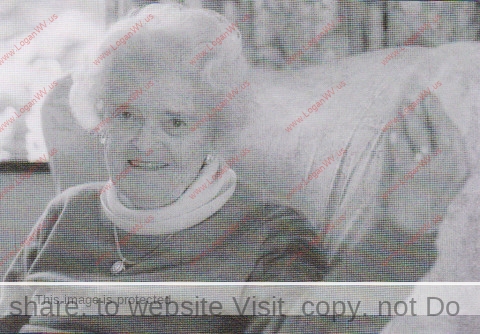
The great-granddaughter of William Dabney Thurmond, founder of the town of Thurmond, and granddaughter of Joseph Samuel Thurmond, a former Speaker of the House of Delegates, Elizabeth Thurmond was born in 1908 at Skelton in Raleigh County. When she was five years old, her family moved to Logan where her father operated the Thurmond Coal Company for many years.
Upon graduation from Logan High School in 1925, Elizabeth went on to Ward Belmont College in Nashville, Tennessee, and later spent three years at The Julliard School in New York where she studied piano.
While in New York, she took advantage of myriad cultural opportunities including concerts, Broadway shows, and other performances. “The teachers were always giving us tickets to something,” she adds. “And if they didn’t have tickets, it cost just $3.50 in those days to get into a show.”
Upon completion of her studies, she returned to Logan where she gave private lessons and taught piano at Logan High School. During the Depression, her father lost his Logan mines and her parents moved to Parkersburg where her father had been appointed collector of internal Revenue. It was on a visit to his office that Elizabeth met Robert E. Witschey, who was employed by her father. Elizabeth and Robert married in 1937.
The Witscheys settled in Charleston where Robert established a successful accounting firm and Elizabeth raised their son and daughter: Walter Witschey, now of Richmond, Virginia, and Sallie Hart of Charleston. Over the years, however, Elizabeth continued to pursue her music, giving many recitals and appearing as a soloist with the West Virginia Symphony and the Charleston Chamber Music Players. She also became an active community advocate for the arts and traveled extensively over the years in this country and abroad.
And there is one more, she says, calling attention to a recent photograph prominently displayed in the living room of her South Hills home in Charleston. It is a photo of her, smiling gleefully as she hugs her infant great-grandson.
“Do you know what his name is?” she asks with obvious delight. She does not wait for an answer. “It’s Logan Cole.”
Would love to see a story about the christien area if anyone has any
Very nice story of one piece of the Logan pie.
Mrs.Witschey was a friend of my Mother. They were in High School in the. 1920s.She was a lovely lady
I visited her when I lived inCharleston
Haskell Johnson was my aunt. Did not know she played piano.
Thank you! Michael Taylor, “a Monaville boy!”
Great story. Thanks for reprinting it.
Thank you for the layout of info.. although I don’t recall any of the photos, I grew from infancy to my teen years on Hoover Trace & Buckfork rds. I was a small boy when Holly and a few others would gather at my Grandpaws home and would play their instruments. I believe Holly played the mandolin, one tune I recall, Twinkle, Twinkle Little Star. Thank you again for the memories….
My mother Elizabeth Henderson daughter of Mitch and Molly Hicks Henderson, Graduated in 1930 LHS, Her brother my uncle Brooke went to LHS played football ..I so enjoyed reading this. Is Mrs Thurmond still Living?
No, she is not still living. The article was written in 2000 when she was 91.
— Admin
I certainly enjoyed reading about Mrs. Elizabeth Thurmond Witschey and her memories of Logan. Miss Thurmond was certainly one of the “privileged” that lived in Logan. And yes, there was another side to Logan, other than the mine wars and the feudin’ & fightin’ . The other side of this story is a harder look into the hollows where the true miner and his family lived. Not such a pretty picture as Miss Thurmond paints. The living was hard, not only for the miner but for his family. As a coal miner’s daughter, I remember just how hard it was to dig out a living on the coal miner’s pay, no warm buns with onion and chili for us.
Ita. Her story was the view of a coal owner’s daughter not the average coal miner’s daughter.
I agree. I was born in Logan, but I lived in the coal camps. Verrry different! I’m glad she had a more cultured and fun growing up, but for most it was survival when there wasn’t even coal mines to rely on, it was ADC.
love the story…loved logan and rum creek…. very interesting…..
Enjoyed the article very much, it’s similar to what I tell people now . . .. that the Logan & Holden you see today is not the Logan / Holden I grew up in. I wasn’t born until shortly after WWII ended, but I remember a lot from the 1950’s & 1960’s. No better place & time to grow up. At home, we never had much, but we never really knew it. BTW, did Stollings have a public swimming pool like mentioned in the pic above of the girls at a swimming pool? If so, where was it? I well remember the Holden Swimming Pool, built by ICCC (Island Creek Coal Company) Holden was the location of the ICCC world headquarters, so it was referred to as a ‘model community’, and we had many entertainment & businesses, schools, etc. etc.. I was there, so I know it’s true !